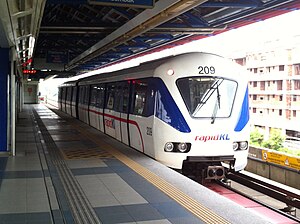Kelana Jaya line
| LRT Kelana Jaya line | |
|---|---|

2-car Innovia Metro 200 at KJ24 Kelana Jaya
|
|
| Overview | |
| Native name | LRT Laluan Kelana Jaya |
| Type | Light rapid transit |
| System | LRT KL System 2 (LRT2) – SelTrac CBTC |
| Status | Fully Operational |
| Locale | Klang Valley |
| Termini |
KJ1 Gombak KJ37 Putra Heights |
| Stations | 37 |
| Services | i) Gombak–Putra Heights ii) Gombak–Ara Damansara |
| Daily ridership | 225,053 (2015) |
| Ridership | 82.144 million (2015) ( |
| Line number | 5 (ruby) |
| Website |
Greater KL / Klang Valley Integrated Transit Map Source: SPAD as at November 2016 |
| Operation | |
| Opened | 1 September 1998 |
| Last extension | 30 June 2016 |
| Owner | Prasarana Malaysia Berhad |
| Operator(s) | Rapid Rail Sdn Bhd |
| Character | Elevated, underground, and at-grade |
| Depot(s) | Subang Depot |
| Rolling stock |
Bombardier Innovia Metro Width: 2.65 m (8 ft 8 in) Length: 67.1 m (220 ft) & 33.7 m (111 ft) |
| Technical | |
| Line length | 46.4 km (28.8 mi) |
| Track gauge | 1,435 mm (4 ft 8 1⁄2 in) Standard gauge |
| Electrification | Fourth rail – Linear induction motor |
| Operating speed | 80 km/h (50 mph) |
The LRT Kelana Jaya line is the fifth rail transit line and the first fully automated and driverless rail system in the Klang Valley area. It is a part of the Greater KL/Klang Valley Integrated Transit System under the Land Public Transport Commission of Malaysia (SPAD). The line is numbered 5 and coloured ruby on the official transit map.
The line runs from Putra Heights through Kelana Jaya to Gombak, serving the Subang Jaya and Petaling Jaya regions to the south; southwest and central Kuala Lumpur, and Kuala Lumpur City Centre to the centre; and low density residential areas further north.
At 46.4 km in length, it is one of the longest fully automated driverless metro system in the world.
The stations are given in a north-south direction, consists primarily of elevated stops and a handful of underground and at-grade stations. Of the 37 stations, 31 are elevated, (Sri Rampai) lies at ground level, and 5 stops (Masjid Jamek, Dangi Wangi, Kampung Baru, KLCC and Ampang Park) are underground.
The stations, like those of the Ampang Line, are styled in several types of architectural designs. Elevated stations, in most parts, were constructed in four major styles with distinctive roof designs for specific portions of the line. KL Sentral station, added later, features a design more consistent with the Stesen Sentral station building. Underground stations, however, tend to feature unique concourse layout and vestibules, and feature floor-to-ceiling platform screen doors to prevent platform-to-track intrusions. 13 stations (including two terminal stations and the five subway stations) utilise a single island platform, while 11 others utilize two side platforms. Stations with island platforms allow easy interchange between north-bound and south-bound trains without requiring one to walk down/up to the concourse level.
...
Wikipedia
